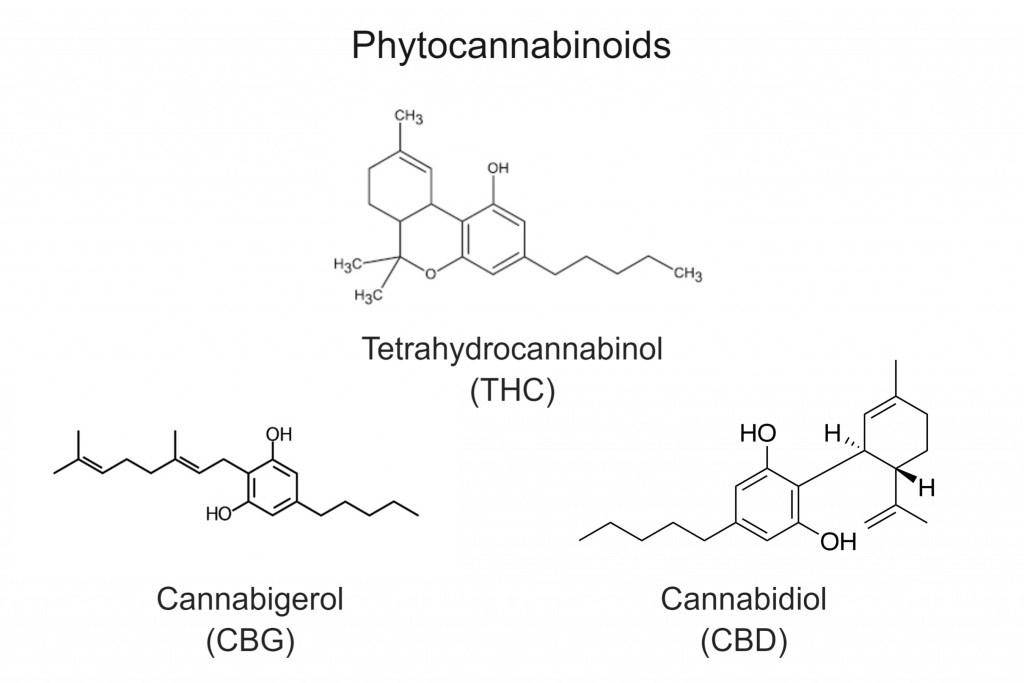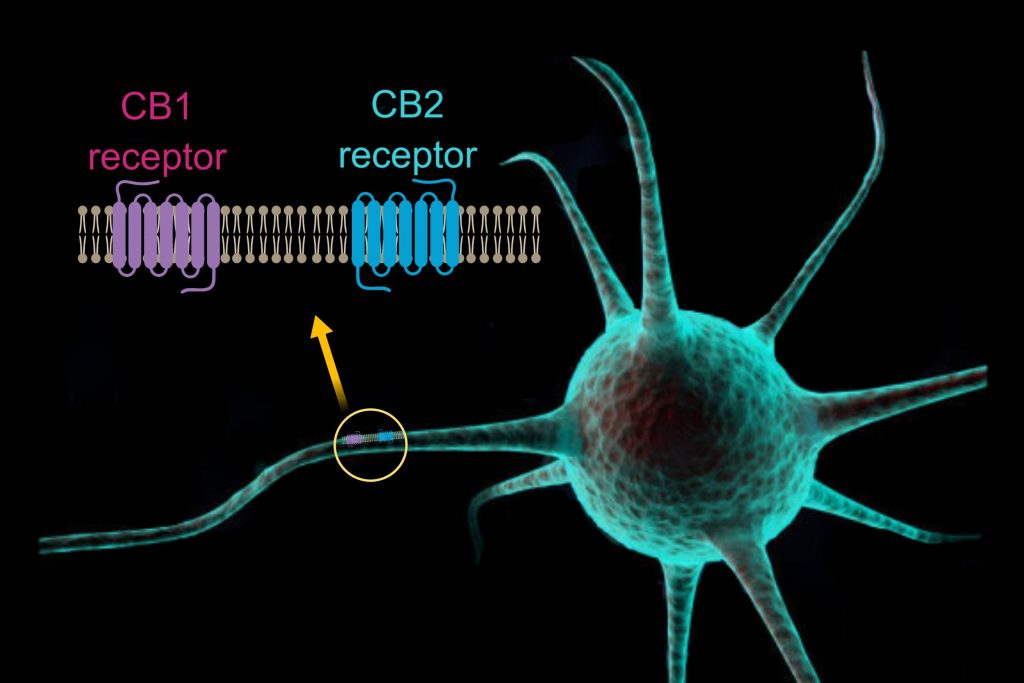10 5.2: Overview of the Endocannabinoid System
After reading this section, you will be able to:
- Know the components of the endocannabinoid system
- Distinguish among the distinct types of cannabinoids
- Describe the different types of cannabinoid receptors including where they are found and what their mechanism of action is
- Describe endocannabinoids action, synthesis, and inactivation
The endocannabinoid system (ECS) is found throughout the brain and rest of the nervous system and is constituted by cannabinoids, cannabinoid receptors, and the endocannabinoid metabolism. The ECS is thought to be involved in the regulation of appetite, inflammation, pain modulation, and possibly cardiovascular protection.
Cannabinoids
Endocannabinoids
Endocannabinoids are natural cannabinoids that are synthesized by the body. So far, five endocannabinoids have been identified but the most studied ones are: anandamide or AEA (N-arachidonoylethanolamine) and 2-AG (2-arachidonoylglycerol) (Figure 2.1). AEA is an agonist for CB1 receptor and is expressed at high levels in the hippocampus, thalamus, cerebral cortex, and cerebellum. It has also been found in the periphery at low levels. 2-AG, on the other hand, is not only an agonist for CB1 receptor, but also for CB2 receptor. It is also found in the brain but in much higher concentrations. Specifically, it is found in the brain stem, hippocampus, striatum, and medulla in rats. It is thought that AEA and 2-AG are both produced “on demand” from membrane phospholipid precursors.

Phytocannabinoids
Phytocannabinoids are found in the cannabis plant and are mostly produced in the resin secreted by the glandular trichomes of female leaves, while male leaves have a small number of trichomes and do not produce many phytocannabinoids. Phytocannabinoids are classified into ten types but the most investigated ones are cannabigerol (CBG), cannabichromene (CBC), cannabidiol (CBD), and tetrahydrocannabinol (THC) (Figure 2.2). Both CBG and CBC do not show any psychoactivity mediated by the CB1 receptor. CBD is among the most abundant phytocannabinoid subtype and has textile uses, while THC is the major compound of C. Sativa that has psychoactive effects.

Synthetic Cannabinoids
Synthetic cannabinoids are produced in the laboratory and found in pharmaceutical products that sometimes are prescribed to help make up for a deficiency of endogenous cannabinoids. If the ECS is not making enough endocannabinoids, these can be supplemented by those found in plants, or they can be created synthetically.
Cannabinoid Receptors

Endocannabinoid receptors are part of the super family of G protein-coupled receptors (GPCRs), which detect molecules outside the cell and initiate an internal cellular response via a transduction pathway (Figure 2.3). Two cannabinoid receptors (CB) have been identified: CB1 and CB2. They are distinct from each other based on their tissue distribution, amino acid sequence, and signalling mechanism.
CB1 receptor
CB1 receptor is densely found in many areas of the brain like the cerebral cortex, hippocampus, basal ganglia, and cerebellum but not in the respiratory centres of the brain. For a long time, these receptors were considered to exist only in brain tissue, but now it is known that they are also expressed in peripheral areas including the spleen, lungs, thymus, and the heart in low amounts. Moreover, CB1 receptors are among the most abundant GPCR in the brain. Findings show that CB1 receptors play a significant role in cognition and memory since they are found in high levels in sensory and motor regions. At the cellular level, CB1 receptors have been found in GABA-ergic and glutamatergic neurons, potentially indicating that they are involved in GABA and glutamate neurotransmission. Interestingly, the distribution of CB1 receptors differs among the neonatal and adult brain. It was found that it is highly abundant in the white matter at early age but less abundant at later age.
CB1 receptors are located in the presynapse which relates to its principal function of inhibiting neurotransmitter release, which is one of the main roles of the ECS in the body. When CB1 receptors are activated, there is a decrease in levels of cyclic adenosine monophosphate (cAMP), leading to an inhibition of protein kinase A (PKA). CB1 receptor activation also stimulates mitogen-activated protein (MAP) kinase activity, and this is a mechanism used by cannabinoids to act on synaptic plasticity, and possibly, neuronal growth.
CB2 receptor
CB2 receptor is particularly found in peripheral organs of the immune system like the spleen, thymus, tonsils, lungs, and testes. It was originally thought that CB2 receptors were absent from the central nervous system, but there is evidence showing that CB2 receptor mRNA and protein expression are found in microglial cells and astrocytes but at a lower level. Additionally, there is increasing evidence that CB2 receptor might participate in a biological protective system against non-protein attacks. This emerging evidence led to the development of synthetic agonists specific for CB2 receptors to induce such protective effects. Since CB2 receptor is not involved in exerting psychoactive effects, many drug companies are currently working on this field.
Endocannabinoid Metabolism
Endocannabinoid Action
Two main functions of endocannabinoids, neuromodulation and immunomodulation, have been suggested. Usually, a pre-synaptic neuron releases high amounts of neurotransmitters form its vesicles to the post-synaptic membrane of another neuron, activating its receptors and initiating a neuronal signal. In contrast, endocannabinoids work as neuromodulators by using a retrograde secretion. In this type of secretion, the neurotransmitter travels from the post-synaptic neuron “backwards” across the synaptic cleft and activates the CB1 receptors in the pre-synaptic neuron. Activation of the CB1 receptor leads to the inhibition of excitatory and inhibitory neurotransmitters release from the pre-synaptic neuronal cells. Additionally, endocannabinoids have an immune function in brain and the periphery. As mentioned before, CB2 receptors are found in various immune cells. When these receptors get activated, they act to attenuate the release of inflammatory factors like TNF-a, IL-2, and nitric oxide and prevent the proliferation and chemotaxis of immune cells.
Endocannabinoid Synthesis and Inactivation
Retrograde messengers, like AEA and 2-AG, do not require vesicles for storage and release. Instead, they are synthesized when needed by the cleavage of plasma membrane phospholipids. Then they are released across the synaptic cleft, activate cannabinoids pre-synaptic receptors, and inhibit various neurotransmitter systems. Specifically, AEA is formed from arachidonic acid and phosphatidylethanolamine precursors, while 2-AG is produced by the hydrolysis of a membrane derived diacylglycerol located in neuronal cell membranes. Inactivation of endocannabinoids occurs by the action of hydrolases. The fatty acid amide hydrolase (FAAH) enzyme is in charge of the degradation of AEA. FAAH is located intracellularly in post-synaptic neurons like astrocytes. Another enzyme called monoacylglycerol lipase (MAGL) is in charge of the inactivation of 2-AG through hydrolysis.
YOU CAN(NABIS) LEARN MORE…
Since cannabinoid receptors are located widely in the nervous system, and cannabinoids interact with different neurotransmitters like dopamine and GABA, cannabis has a novel potential in medicine to treat a variety of disorders.
Summary Video: Cannabis and the Endocannabinoid System
Click here to watch this video on YouTube:
Challenge Yourself!
